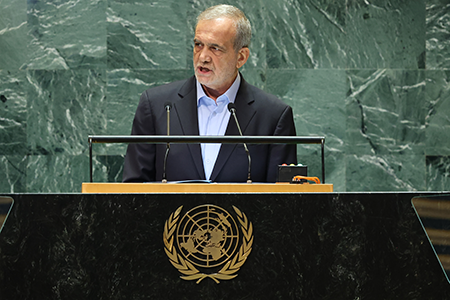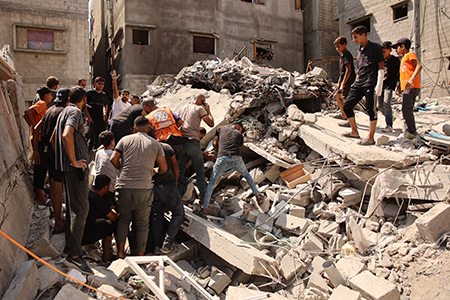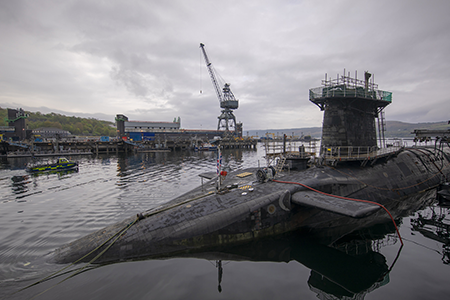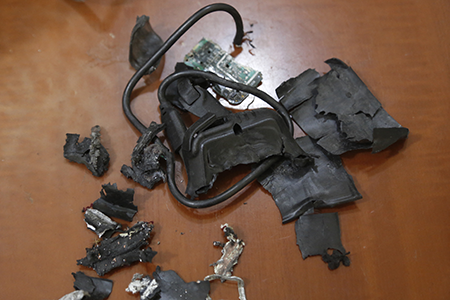"I find hope in the work of long-established groups such as the Arms Control Association...[and] I find hope in younger anti-nuclear activists and the movement around the world to formally ban the bomb."
October 2024
By Matthew R. Costlow
I read with some dismay Frank von Hippel’s “The 1970s ICBM ‘Window of Vulnerability’ Still Lingers” in the September 2024 issue of Arms Control Today. In making his case concerning the alleged dangers of U.S. intercontinental ballistic missiles (ICBMs), he errs on matters of policy, strategy, and operations to such a significant degree that I believe a public correction of the record is necessary.
Von Hippel states that “[t]he primary advantage of a launch-under-attack posture is its low cost. Its major disadvantage is the danger of accidental launch.” Addressing both assertions in turn, the U.S. ability to launch its ICBMs under attack is one option among many for a president facing an apparent attack. But the advantage of this posture lies in its deterrence effect, not in its cost. Even an ICBM force in a de-alerted state would constitute a “low cost” posture and thus cannot be why U.S. officials in Democratic and Republican administrations have long seen an advantage in keeping U.S. ICBMs on alert. Instead, as the historical record attests, U.S. officials see a great advantage in complicating adversary targeting plans by retaining the option of launching ICBMs while adversary missiles are still in flight. This approach leaves open the possibility that the adversary will have expended potentially thousands of warheads for no apparent military gain, not to mention the incoming U.S. response.
On the matter of accidental launch, von Hippel expands on his concern by stating without citation or evidence, “In contrast to this redundancy of positive controls to assure the ICBMs would be launched if ordered, there is not a single system to deal with the possibility of a mistaken or unauthorized launch.” He correctly notes that ICBMs can be launched, with proper authorization from the chain of command, from one of five launch control centers or an airborne asset called “airborne launch control system.” What he fails to note is that each of these systems can issue “inhibit launch” orders against the silo or silos in question. Far from “not a single system” to address the possibility of unauthorized launch, there is a host of systems and procedures built for that exact purpose, including manual locks, safing pins, and more.1
The Air Force is not a passive observer of the issue either. It conducts “Unauthorized Launch Studies” to red-team potential problems and undertakes “Threat Mitigation Plans” if any problems are found.2 Unsurprisingly, the Air Force mandates numerous redundant safeguards for the software used in nuclear systems that are biased toward making it far easier to inhibit a launch than to enable it.3 As the Defense Department states, “The U.S. alert system prioritizes surety over speed.”4
The policy debate over the value of ICBMs in U.S. nuclear strategy can continue usefully only if all sides have a clear understanding of the safeguards in place to prevent unauthorized or accidental launches.
ENDNOTES
1. See U.S. Air Force, “Safety Rules for the Intercontinental Ballistic Missile System,” AFI91-114, January 6, 2023.
2. U.S. Air Force, “Unauthorized Launch, Threat Mitigation, and Launch Action Studies,” AFI91-106, August 28, 2019.
3. U.S. Air Force Headquarters, “Department of the Air Force Guidance Memorandum (DAFGM) to Department of the Air Force Manual (DAFMAN) 91-119, Safety Design Criteria for Nuclear Weapon Systems Software,” DAFMAN91-119_DAFGM2024-01, June 11, 2024.
4. U.S. Department of Defense, “Report on the Nuclear Employment Strategy of the United States - 2020,” n.d., p. 6, https://www.esd.whs.mil/Portals/54/Documents/FOID/Reading%20Room/NCB/21-F-0591_2020_Report_of_the_Nuclear_Employement_Strategy_of_the_United_States.pdf.
Matthew R. Costlow is a senior analyst at the National Institute for Public Policy.
The United States accused Iran of sending ballistic missiles to Russia, but Iran denied the accusation.
October 2024
By Kelsey Davenport
The United States accused Iran of sending ballistic missiles to Russia, an accusation Iran denied.
Iran reached an agreement with Russia to transfer hundreds of missiles in 2023, according to the U.S. Treasury Department, but the Sept. 10 announcement was the first time that the United States confirmed that Iran shipped any missile systems to Russia.
U.S. Secretary of State Antony Blinken said in a Sept. 10 press conference in London that the United States had warned Iran publicly and privately that transferring the missiles would be a “dramatic escalation.” Blinken said that Russia is likely to use the weapons within the next several weeks.
Iran called the accusation “a vile propaganda ploy” and said that the United States is disseminating “misleading information.”
Iran was prohibited from transferring missiles and related technologies under UN Security Council Resolution 2231, which endorsed the 2015 nuclear deal known as the Joint Comprehensive Plan of Action and modified UN sanctions on Iran. The missile restrictions expired in October 2023. Prior to the expiration, Iran transferred drones to Russia in violation of the UN restrictions. Iran admitted to exporting some drones, but denied it was a violation of Resolution 2231.
The United States and European countries responded to the missile transfer by announcing additional sanctions against Iran, including against Iran Air.
France, Germany, and the United Kingdom said in a Sept. 10 statement that the transfer of missiles is “a direct threat to European security.” The move is “further escalation of Iran’s military support to Russia’s war of aggression against Ukraine and will see Iranian missiles reaching European soil,” the statement said.
The Russian Foreign Ministry said that Tehran and Moscow are cooperating in “sensitive” areas, but did not confirm or deny the transfer of missiles.
Blinken said the missile involved was the Fath-360, which has a range of 75 miles. He said Russian military personnel were trained in Iran to use that system and suggested that Russia will use the Iranian systems for “closer-range targets.”
U.S. National Security Council spokesman John Kirby said that Iran benefits militarily from the security relationship with Russia. The two countries share technology and tactics, he said.
Masoud Pezeshkian made his overture to the United States and other key countries in his first address to the General Assembly since being elected Iran’s new leader in July.
October 2024
By Kelsey Davenport
Iranian President Masoud Pezeshkian has offered to open new nuclear negotiations with the United States and its partners in return for lifting sanctions that are crippling his country’s economy.

In his first appearance at the UN General Assembly since being elected in July, Pezeshkian criticized U.S. President Donald Trump’s unilateral withdrawal from the 2015 nuclear agreement, known as the Joint Comprehensive Plan of Action (JCPOA), and “coercion-driven” sanctions strategy as “a threat-ridden approach.”
Arguing that “we have the opportunity… to enter a new era,” Pezeshkian said in his Sept. 24 speech that “[w]e are ready to engage with JCPOA participants” and “[i]f JCPOA commitments are implemented fully and in good faith, dialogue on other issues can follow.”
Pezeshkian’s focus on engagement with the United States and Europe marks a shift from his predecessor, Ebrahim Raisi, who derailed an opportunity to restore the JCPOA in 2022 and cast doubt on Iran’s commitment to nuclear negotiations. (See ACT, October 2022.)
But Iran’s recent decision to ship missiles to Russia and escalating tensions between Israel and Iranian-backed proxies in the region make it more challenging politically for the United States to accept Pezeshkian’s overture.
Meanwhile, Iranian Foreign Minister Abbas Araghchi has made clear that Iran will not wait until after the U.S. presidential election on Nov. 5 to negotiate over its nuclear program and believes that the 2015 nuclear deal could provide a basis for a future agreement.
In an interview with state-run IRIB News on Sept. 15, Araghchi said that it is not surprising that the United States does not want to negotiate before its presidential election but that Iran is prepared to move forward now and engage with other countries. He said previously that the JCPOA cannot be restored, but his latest comments suggested that the agreement still provides a suitable framework for future talks.
Araghchi’s comments came after Iran’s supreme leader, Ayatollah Ali Khamenei, said in an Aug. 27 speech that the United States cannot be trusted but that there is “no harm” in interacting in “certain situations.”
The Biden administration continues to suggest that it is waiting for Iran to take the first step back to negotiations. The U.S. State Department said in response to Khamenei’s comments that if Iran wants to “demonstrate seriousness or a new approach,” it should stop its nuclear escalations and “start meaningfully cooperating” with the International Atomic Energy Agency (IAEA).
IAEA Director-General Rafael Mariano Grossi told the agency’s Board of Governors on Sept. 9 that there has been “no progress in resolving the outstanding safeguards issues” with Iran.
The IAEA continues to seek answers from Iran about the presence of uranium detected at two locations that were never declared to the agency. (See ACT, July/August 2022.)
He said Iran’s assertions that “it has declared all nuclear material, activities, and locations” as required by its safeguards agreement is “inconsistent” with the agency’s findings. The IAEA must resolve these questions to provide assurance that Iran’s nuclear program is “exclusively peaceful,” Grossi said.
Grossi also told the board that Pezeshkian agreed to meet “at an appropriate juncture.” He encouraged Iran to facilitate the meeting so that Tehran and the agency can “establish a constructive dialogue that leads swiftly to real results.”
In a joint statement to the IAEA board on Sept. 13, France, Germany, the United Kingdom, and the United States reiterated that Iran’s “continued stonewalling runs contrary to its legal obligations” under its safeguards agreement. There is “reasonable doubt about the nature of Iran’s nuclear activities” as long as the IAEA’s concerns persist, the states said.
They added that “further action by the Board will be necessary” if Iran does not cooperate with the agency, including asking the IAEA to compile a comprehensive report on Iran’s nuclear program to inform a decision about what additional steps the board should take.
Although the states may push for a report, Grossi suggested it is not necessary. He said in the Sept. 9 press conference that the IAEA already has provided an assessment of what occurred at Iran’s undeclared locations and is focused on resolving the issues.
In a separate report on Aug. 29, the IAEA noted that Iran installed and began operating additional advanced centrifuges at its uranium-enrichment facilities over the past few months.
According to the report, Iran installed an additional 10 cascades of IR-2 centrifuges at the fuel enrichment plant at Natanz, bringing the total number of cascades to 31. Of the 31, 15 are now being used to enrich uranium, six more than the IAEA reported as operational in May.
The IAEA also reported that Iran installed an additional eight cascades of IR-6 centrifuges at the Fordow enrichment plant. Tehran announced the installation in June, but is not yet operating any of those machines. (See ACT, July/August 2024.) Enrichment at Fordow is more concerning from a proliferation perspective because the facility is buried deeply in the mountains, making it more difficult to target in a military operation.
Iran’s stockpile of highly enriched uranium (HEU) grew over the past quarter. The IAEA reported that Iran’s stockpile of uranium enriched to 60 percent uranium-235 was 165 kilograms as of Aug. 17, up nearly 29 kilograms from May, and its stockpile of uranium enriched to 20 percent U-235 grew from 751 kilograms to 814 kilograms.
Uranium enriched to 60 percent and 20 percent U-235 can be enriched more quickly to 90 percent U-235, which is considered weapons grade.
In a Sept. 10 statement to the IAEA board, U.S. Ambassador Laura Holgate said that if Iran is “interested in building confidence in the exclusively peaceful nature of its nuclear program, it should down-blend its 60 percent [U-235] stockpile and stop such production entirely.”
Iran’s HEU has “no credible civilian purpose,” Holgate said. She urged Iran to be fully transparent regarding its uranium- enrichment activities.
In a new report, António Guterres reaffirmed the need to preserve human control over the use of force and said “[t]he autonomous targeting of humans by machines is a moral line that must not be crossed.”
October 2024
By Michael T. Klare and Xiaodon Liang
UN Secretary-General António Guterres reaffirmed the need for urgent action to preserve human control over the use of force in a new report that he said reflects “widespread recognition” by UN member-states of the potential harmful effects of lethal autonomous weapons systems.

Released on Aug. 6, the report summarizes the views of 73 states and 33 civil society organizations, including Human Rights Watch and the Arms Control Association, on the challenges posed by autonomous weapons systems. It was mandated by a UN General Assembly resolution passed in December. (See ACT, December 2023.)
“There is widespread concern that those weapons systems have the potential to change warfare significantly and may strain or even erode existing legal frameworks,” Guterres said in the conclusion section of the report.
He also found “widespread recognition” that human control is essential to ensure accountability, responsibility, and compliance with international law and a “strong sense that time is running out for the international community to take preventive action on this issue.”
Guterres stressed “the need to act urgently to preserve human control over the use of force” and called for the conclusion by 2026 of a “legally binding instrument to prohibit lethal autonomous weapons systems that function without human control or oversight and that cannot be used in compliance with international humanitarian law.”
“The autonomous targeting of humans by machines is a moral line that must not be crossed,” he said.
Although Guterres emphasized common ground, there are signs of continued international division over potential responses to the lethal autonomous weapons challenge. In a section of the report summarizing state submissions, Guterres highlighted differences between states that favored continuing discussion of such responses solely within the framework of the Convention on Certain Conventional Weapons (CCW) and states that preferred advancing discussions toward a legally binding treaty in other venues, such as the UN General Assembly.
In its analysis of the report, the Stop Killer Robots advocacy organization said that, of the 58 submissions from states or groups of states, 47 states expressed support for some form of prohibition or regulation of lethal autonomous weapons systems. But many prominent countries remain opposed to or are undecided on a potential treaty regulating these weapons, including China, India, Israel, Japan, Russia, the United Kingdom, and the United States, it said.
Many of the positions identified by Guterres also were debated at two recent international gatherings on lethal autonomous weapons systems.
The first of these was a session of the CCW group of governmental experts held in Geneva on Aug. 26-30. It was convened in accordance with a 2023 decision by the CCW states-parties instructing the experts group to extend its work until 2026 “to further consider and formulate, by consensus, a set of elements of an instrument…to address emerging technologies in the area of lethal autonomous weapon systems.”
At the Geneva meeting, delegations debated elements of a legally binding measure to ban or restrict the use of lethal autonomous weapons systems. Much of the debate concerned terminology, particularly the “characterization,” or definition, of the systems and the degree of human oversight required to prevent such devices from violating international humanitarian law.
Many delegations expressed support for legally binding restrictions on the deployment of these systems, but several states, notably India, Israel, Russia, and the United States, opposed overly restrictive language on their use. Because decisions at the experts group meetings are made by consensus, very little was agreed at the August session, prompting many delegations to express support for considering a binding instrument in the UN General Assembly.
The consensus procedure at the experts group “should not be an excuse to defeat the purpose of regulating the issue of [lethal autonomous weapons systems] through delays or procrastinations,” the Brazilian delegation said. Instead, “all avenues should be explored in order to achieve the best possible instrument, with the largest number of adherents, and that is to be able to be put into force the soonest.”
The debate continued Sept. 9-10 in Seoul at the REAIM (Responsible AI in the Military Domain) summit. Organized by South Korea, the meeting drew representatives from 90 countries and academics, scientists, and other specialists. This was the second REAIM summit, following an initial event at The Hague in February 2023.
The REAIM summit process differs from the CCW experts group meetings because it addresses the full range of artificial intelligence (AI) applications to military operations, not just its use in lethal autonomous weapons systems, and because it entertains nonbinding, voluntary measures only. (See ACT, April 2023.)
At the summit, panelists considered the risks and benefits of employing AI in the military domain, with some speakers arguing that AI could be used to reduce, as well as increase, the risks of humanitarian harm. Panel discussions also focused on possible strategies for minimizing the negative consequences of applying AI to military use, especially with respect to the proliferation or unintended use of weapons of mass destruction.
Following a ministerial roundtable on the second day of the summit, 61 countries signed a “blueprint for action” to guide future efforts in this field.
Claiming that AI can be used for benign as well as malicious purposes, the blueprint calls on states “to establish national strategies, principles, standards and norms, policies and frameworks and legislation as appropriate to ensure responsible AI applications in the military domain.”
Such measures could include, for example, “appropriate safeguards to reduce the risk of malfunctions or unintended consequences, including from data, algorithmic, and other biases.”
Despite the nonbinding nature of the blueprint and its relatively unrestrictive proposals, 30 countries, including China, did not sign the document. Chinese Foreign Ministry spokesperson Mao Ning did not explain Beijing’s reasons for abstaining, but said that “China will remain open and constructive in working with other parties” on the issue of AI regulation.
The next major venue for addressing international constraints on the development and deployment of lethal autonomous weapons system will be the First Committee of the UN General Assembly in October in New York.
In addition to revealing a uranium-enrichment facility and a new, larger launch vehicle for long-range missiles, leader Kim Jong Un pledged to expand the country’s nuclear arsenal.
October 2024
By Kelsey Davenport
North Korea revealed a uranium-enrichment facility and a new, larger launch vehicle for long-range missiles as leader Kim Jong Un pledged to expand the country’s nuclear arsenal.

In a Sept. 10 speech marking the country’s founding, Kim said that North Korea will “steadily bolster its nuclear force” to effectively respond to “any acts of threat imposed by nuclear-armed rivals.” He also repeated past calls for an exponential increase in the country’s stockpile of nuclear weapons.
Several days after the speech, Kim visited the state’s Nuclear Weapons Institute. North Korean media released images of him walking through an unnamed facility filled with centrifuges, which are used to enrich uranium.
North Korea frequently displays pictures of its missiles and occasionally shares photos of warheads, but it generally has guarded the secrecy of its uranium-enrichment program. The photographs, published Sept. 13, did not disclose the location of the centrifuges.
North Korea is known to have a uranium-enrichment facility at Yongbyon, the nuclear complex where the country’s plutonium-producing reactor is located, and is suspected of operating additional centrifuges at unknown sites. A team of experts, including Jeffery Lewis from the James Martin Center for Nonproliferation Studies, identified Kangson as one of the uranium-enrichment facilities in 2018. In a Sept. 13 post on the social platform X, Lewis pointed out features from the photos that are consistent with satellite images of Kangson.
According to the Sept. 13 report on Kim’s visit from the state-run Korean Central News Agency (KCNA), Kim “set forth important tasks concerning a long-term plan for increasing the production of weapons-grade nuclear materials.” He said it is necessary for North Korea to “further increase the number of centrifuges” and enhance the efficiency of the machines. He said North Korea is ready to move forward with a new type of centrifuge.
Siegfried Hecker, a U.S. nuclear physicist and former head of Los Alamos National Laboratory, visited North Korea’s centrifuge facility at Yongbyon in 2010. The centrifuges shown in the Sept. 13 images are a different model than the machines Hecker observed on his trip. It is not clear from the photos how many of the centrifuges depicted are operational. Some machines are not connected yet, suggesting that North Korea is expanding its capacity.
According to KCNA, Kim noted the importance of producing fissile material for “the manufacture of tactical nuclear weapons.”
North Korea does not disclose the size of its nuclear arsenal, and uncertainty over its production capabilities makes it difficult to assess the number of warheads that the country possesses. In a July report, experts at the Federation of American Scientists estimated that North Korea has produced enough weapons-grade material for about 90 weapons but may have assembled only about 50 warheads.
Kim justified the expansion by saying U.S. threats and the regional security environment make it necessary for North Korea to “bolster up its military capability for self-defense” and for “preemptive attack with the nuclear force as the backbone.”
U.S. State Department spokesperson Matthew Miller said in a Sept. 13 press briefing that the images of North Korea’s centrifuges do not change U.S. policy. The United States “will defend our South Korean and Japanese allies, and we’ll continue to work for the full denuclearization of the Korean peninsula,” he said.
National Security Council spokesperson John Kirby said that the United States continues to monitor North Korea’s “progression in their nuclear ambitions as well as their ballistic missile technology and program.”
He said that monitoring North Korea’s advances is one reason why the Biden administration devoted more “intelligence, surveillance, and reconnaissance assets, prioritizing those for the area on and around the Korean peninsula.”
North Korea also published a photo of Kim inspecting a transport erector launch vehicle that appears larger than vehicles the country has used in the past for its intercontinental ballistic missiles (ICBMs). The photo, published Sept. 8, shows a 12-axle launch vehicle, which suggests that North Korea may be working on a larger, more powerful ICBM. North Korea launches the Hwasong-17, its largest known ICBM, using an 11-axle launch vehicle.
In a Sept. 11 joint statement, the defense ministers of the participating states of the UN Command and South Korea strongly condemned North Korea’s illegal nuclear and missile programs, which “seriously undermine international non-proliferation regimes.”
The UN Command, which is comprised of the states that fought against North Korea in the Korean War, welcomed Germany as a new member, bringing the number of participating states to 18.
The defense ministers said they would “remain united upon the renewal of hostilities or armed attack on the Korean peninsula.” They pledged to “reinforce combined exercises and training” in response to security threats and explore options for strengthening the UN Command.
North Korea responded to the meeting by accusing the United States of “buckling down” to draw additional states into its aggressive military drills.
In a Sept. 13 statement published in KCNA, the Disarmament and Peace Institute within the North Korean Foreign Ministry said the UN Command meeting is aimed at revitalizing a “tool for war and confrontation.” It accused the UN Command states of “further increasing the possibility of military conflict.”
The “collective military confrontation” against North Korea will motivate Pyongyang to accelerate the formation of a “just strategic axis” to correct the imbalance of power in the region, the statement said.
The institute did not define the “strategic axis,” but it may have been referring to North Korea’s growing partnership with Russia.
Russian President Vladimir Putin and Kim signed a treaty during Putin’s visit to North Korea in June that included pledges to strengthen military cooperation and provide assistance in response to an armed invasion. (See ACT, July/August 2024.)
The UN Command joint statement “expressed serious concern” over the growing partnership between North Korea and Russia.
The decision by Canada and the United Kingdom to ban or otherwise restrict arms transfers to Israel over the Gaza War follows similar decisions by Belgium, Italy and Spain.
October 2024
By Michael T. Klare
In what appears to be a growing trend, Canada and the United Kingdom recently joined several other NATO members in banning or otherwise restricting arms transfers to Israel due to its military operations in Gaza.

Belgium, Italy, and Spain already had imposed such measures, claiming that Israel’s relentless air and artillery strikes on Gaza, which have killed an estimated 40,000 people and flattened most residential areas, have violated international law.
The addition of Canada and the UK to this list suggests a growing policy rift with the United States, which is Israel’s major arms provider, responsible for 69 percent of the country’s imports over the past five years, according to the Stockholm International Peace Research Institute.
The UK decision to constrain arms transfers to Israel was announced Sept. 2 by Foreign Secretary David Lammy, who told Parliament that, under the UK Export Control Act of 2002, military gear cannot be exported to any country in which “there is a clear risk that the items might be used to commit or facilitate a serious violation of international humanitarian law.”
After an examination of all outstanding arms export licenses to Israel, several dozen were found to pose a “clear risk” of violating international law and so had been suspended by the government, he said.
As described by Lammy, the UK is not halting all arms exports to Israel, only those “that we assess [are] for use in the current conflict in Gaza,” such as key components for fighter aircraft, helicopters, and drones. The government’s decision also exempts parts for the F-35 fighter aircraft, which Israel has used for air strikes in Gaza, because the planes are being manufactured as part of a multinational program. “Suspending all licenses for the F-35 program would undermine the global F-35 supply chain that is vital for the security of the UK, our allies, and NATO,” he explained.
Lammy’s announcement was welcomed by many members of Parliament who have been pushing for a tough stance on Israel, but was criticized by Israeli leaders, who viewed it as a betrayal of a close ally, and by human rights activists, who claimed it did not go far enough.
Israeli Prime Minister Benjamin Netanyahu was especially disparaging, calling the UK decision “shameful” and saying that “[w]ith or without British arms, Israel will win this war and secure our common future.”
Amnesty International, in its response, said the government’s move was “too limited and riddled with loopholes.” The group was particularly critical of the decision to exempt parts for the F-35 fighters, saying it was “a catastrophically bad decision for the future of arms control and misses a clear obligation to hold Israel accountable for its extensive war crimes and other violations.”
Anger over Israel’s perceived misconduct in Gaza also has provoked strong public opposition within Canada to arming Israel. That pressure led Prime Minister Justin Trudeau’s government to stop approving new permits for arms exports to Israel on Jan. 8.
This decision did not cover permits that had been approved previously, provoking widespread criticism from human rights and pro-Palestinian groups. After months of protests, the government announced on Sept. 10 that it would halt all arms shipments to Israel, even those stemming from older permits.
Following the Jan. 8 decision, “I asked my department to look into any existing permits of arms or parts of arms that could have been sent to Israel,” Foreign Affairs Minister Mélanie Joly told reporters on Sept. 10, according to the Canadian Broadcasting Corp. After that, “I suspended this summer around 30 existing permits of Canadian companies,” she said. “We will not have any form of arms or parts of arms be sent to Gaza, period.”
Joly provided few details about the suspensions, provoking further criticism. Heather McPherson, a foreign affairs specialist for the New Democratic Party, said that Joly’s latest announcement “absolutely” does not meet her concerns. “For her to take months and months and months to take action [on the existing permits] is appalling,” she told reporters.
Neither Canada nor the UK are major arms exporters to Israel, providing less than 1 percent of its annual dollar value of military imports. Nevertheless, their decision to restrict sales over Israel’s actions in Gaza constitute a major political statement, demonstrating diminishing international support for Israel’s continued military operations.
The United Kingdom and the United States said their decision to extend their mutual defense agreement indefinitely is in response to rising threats.
October 2024
By Shizuka Kuramitsu
The United Kingdom and the United States, responding to perceived rising threats, are seeking to bolster nuclear cooperation by indefinitely extending their mutual defense agreement prior to its expiration at the end of the year.

On July 25, Karen Pierce, the UK ambassador to the United States, and Bonnie Jenkins, the U.S. undersecretary of state for arms control and international security, signed a pledge to amend the agreement. The UK Parliament and the U.S. Congress are now considering acting on the amendment, which includes a clause deleting references to the expiry date.
The mutual defense agreement has allowed the two allies to exchange nuclear materials, technology, and information related to nuclear weapons, naval nuclear propulsion, and nuclear threat reduction since 1958 and has been renewed several times.
The agreement underpins the special UK-U.S. defense relationship and is considered unique among nuclear-weapon states because of the level of dependency and technical integration. Areas of recent collaboration include nuclear weapons modernization projects and safeguards.
By extending the agreement indefinitely, the proposed amendment streamlines the UK-U.S. exchange of nuclear materials and components of nuclear weapons and submarine reactors. “The exception to this is information sharing, which either state can end unilaterally at certain times if they give one year’s notice,” according to a report on Sept. 11 by Nuclear Information Service, a UK think tank.
The change fosters bilateral nuclear cooperation amid rising nuclear threats from their adversaries, namely Russia and China. David Cullen, director of the Nuclear Information Service, told the Financial Times on Sept. 2 that the amendment “provides a permanent underpin to the modernization of the UK’s nuclear deterrent.”
“It also locks in cooperation over AUKUS,” he said, referring to the Australia-UK-U.S. agreement to supply Australia with nuclear-powered submarines and other defense cooperation.
Discussing the agreement at an event in Washington on July 29, Jill Hruby, administrator of the U.S. National Nuclear Security Administration, said that the two countries “are closely aligned, with our W93 [nuclear warhead] program and their [UK] replacement warhead program Astraea.”
The allies also “are working together to create a new development and training center for [International Atomic Energy Agency] safeguards, and we are discussing a mutual resilience strategy for our nuclear deterrence, and importantly…we are working to provide Australia with a nuclear-powered, conventionally armed submarine capability under the AUKUS agreement,” Hruby added.
The amended agreement was submitted to the UK and U.S. legislative bodies in July.
The amendment is “consistent…with United States commitments to the United Kingdom regarding the development and deployment of the United Kingdom TRIDENT Strategic Weapon System, continued cooperation in nuclear propulsion programs, and support for the United Kingdom atomic weapon and nuclear threat reduction programs,” U.S. President Joe Biden said in a letter to Congress on July 29.
Sens. Tim Kaine (D-Va.), Deb Fischer (R-Neb.), Tom Cotton (R-Ark.), and Angus King (I-Maine) proposed an amendment extending the agreement as part of the National Defense Authorization Act for fiscal year 2025. The amendment must be approved by both houses of Congress.
In the UK, the amended agreement was presented to Parliament on July 26. It will be enacted automatically unless the House of Commons or the House of Lords passes a resolution objecting to the amendment before Oct. 23.
On Sept. 2, seven members of Parliament requested a parliamentary debate, called an Early Day Motion, due to concerns that the extension “violates both countries’ obligations” under the nuclear Nonproliferation Treaty (NPT).
The explanatory memorandum attached to the amendment signed by John Healey, the UK defense secretary, on July 26 says that the agreement “does not provide for the transfer of nuclear weapons or other nuclear explosive devices, or control over such weapons or explosive devices” and therefore “[o]ur cooperation under the [agreement] is consistent with the UK's obligations” under the NPT.
The initiative is designed to address an era of global transformation and catastrophic risk.
October 2024
By Shizuka Kuramitsu
World leaders kicked off a new UN initiative designed to address an era of global transformation and catastrophic risk by adopting a “pact for the future” that includes renewed promises to uphold long-standing disarmament obligations and commitments.

The leaders convened the first Summit for the Future on Sept. 22-23 on the sidelines of the UN General Assembly in New York. The groundwork for the meeting was laid in 2022 when the General Assembly adopted a resolution authorizing a summit process that is intended to reaffirm the UN Charter, reinvigorate multilateralism, boost implementation of existing commitments, agree on concrete solutions to challenges, and restore trust among member states.
“Our collective security system is threatened by geopolitical divides, nuclear posturing, and the development of new weapons and threats of war,” UN Secretary-General António Guterres warned in a statement opening the summit on Sept. 22.
“Our multilateral tools and institutions are unable to respond effectively to today’s political, economic, environmental, and technological challenges, and tomorrow’s will be even more difficult and even more dangerous,” he said.
“We must take the first decisive steps towards updating and reforming international cooperation to make it more networked, fair, and inclusive now…. [T]oday, thanks to your efforts, we have,” Guterres added, referring to the summit outcome document.
The summit approved the pact by consensus after an unsuccessful effort to prevent action led by Russia and backed by Belarus, Iran, Nicaragua, North Korea, Sudan, and Syria.
The document paints the present era as “a time of profound global transformation” in which the world is “confronted by rising catastrophic and existential risks, many caused by the choices we make.”
It notes that “[f]ellow human beings are enduring terrible suffering” and warns that “[i]f we do not change course, we risk tipping into a future of persistent crisis and breakdown.” The summit affirmed that its outcomes are important given the challenges posed to the multilateral systems particularly on disarmament issues.
Mexican Foreign Secretary Alicia Bárcena Ibarra called the pact more than “just another United Nations document” because it addresses three specific issues: “the imperative of a world free of nuclear weapons in a context of high military tension; second, the unequivocal need for financing for development; third, the need for reforms to multilateral governance, identifying guidelines for the reform of the [UN] Security Council and the international financial architecture.”
Guterres emphasized that the pact represents “the first agreed multilateral support for nuclear disarmament in more than a decade.”
The nuclear disarmament section was the result of intensive discussions among the five nuclear-weapon states recognized under the nuclear Nonproliferation Treaty (NPT) and members of the New Agenda Coalition, which includes Brazil, Egypt, Ireland, Mexico, New Zealand, and South Africa, diplomatic sources said.
In it, pact supporters expressed “deep concern over the state of nuclear disarmament” and promised to advance the goal of a world free of nuclear weapons; uphold “our respective obligations and commitments” set out in treaties, protocols, and established norms; and “take all steps to prevent nuclear war.”
The pact seeks to revitalize the role of the United Nations in the field of disarmament, including by recommending that the General Assembly pursue work that could support preparation of a fourth special session devoted to disarmament.
Further, the document includes action plans to accelerate efforts to address the potential risks associated with new and emerging technologies involving lethal autonomous weapons systems and the space realm.
The United States continues to weigh appeals from Ukraine to use U.S.-origin missiles against targets behind Russian frontlines.
October 2024
By Xiaodon Liang
The United States continues to weigh a request from Ukraine to use U.S.-origin missiles against targets deep behind the frontlines of the continuing full-scale Russian invasion.

At a Sept. 6 meeting in Ramstein-Miesenbach, Germany, of states supporting the Ukrainian war effort, Ukrainian President Volodymyr Zelenskyy renewed a call on the United States and other countries to permit use of long-range missiles against “the Russian territory so that Russia is motivated to seek peace.”
In his statement, Zelenskyy referred not only to the U.S.-supplied Army Tactical Missile System (ATACMS), a ground-launched ballistic missile, but also weapons provided by other countries that incorporate U.S. components or licensed technology, such as the French-British Storm Shadow/SCALP-EG air-launched cruise missile.
Although Ukraine referred to these weapons as “long-range” systems, the ATACMS is a short-range ballistic missile with an estimated range of 300 kilometers. The Storm Shadow/SCALP-EG missile has an estimated range of up to 550 kilometers. (See ACT, June 2024; November 2023.)
U.S. President Joe Biden discussed the Ukrainian request in a Sept. 13 meeting with UK Prime Minister Keir Starmer in Washington, but no change in U.S. policy was announced following the event. Starmer is understood to have argued in favor of Ukraine’s request at the meeting, the Associated Press reported.
U.S. officials are skeptical that permitting deep strikes with U.S.-origin missiles into Russia will create a military advantage for Ukraine. In a statement to the Associated Press, a Pentagon spokesperson said that ATACMS missiles do not have the range to target Russian combat aircraft that deliver glide bombs, which are now a priority threat for Ukraine.
Following the Sept. 6 meeting in Germany, U.S. Defense Secretary Lloyd Austin, responding to a question about long-range strikes, said, “I don’t believe that one specific capability is going to be decisive.” Speaking at a U.S. Air Force base in Alabama a week later, Austin pointed out that Ukraine has conducted successful deep strikes with its own drone systems. (See ACT, July/August 2024.)
U.S. officials also are concerned that Russia might respond to a U.S. decision to approve Zelenskyy’s request by providing Iran with technological support to target U.S. forces in the Middle East, The New York Times reported on Sept. 12.
Russian President Vladimir Putin warned on Sept. 12 that acceding to the Ukrainian request would mean that the United States and other providers of missiles “are parties to the war in Ukraine.”
“This will mean their direct involvement in the conflict, and it will clearly change the very essence, the very nature of the conflict dramatically,” he said in a comment to the press in St. Petersburg.
In response, John Kirby, the White House national security communications adviser, said at a Sept. 13 press conference that “we take these comments seriously, but it is not something that we haven’t heard before.” In a Sept. 17 interview with The Times of London, NATO Secretary-General Jens Stoltenberg said, “[T]here have been many redlines declared by [Putin] before, and he has not escalated.”
Zelenskyy is scheduled to meet Biden on Sept. 26 on the sidelines of the UN General Assembly in New York, the White House said.
Amended Protocol II of the Convention on Certain Conventional Weapons prohibits the production of large quantities of apparently harmless objects that are constructed to contain explosive material, experts say.
October 2024
By Carol Giacomo
Israel’s use of exploding pagers and walkie-talkies during its conflict with Hezbollah in Lebanon appears to violate international law, an expert said.

“Based on the currently available information…there is a strong basis to conclude Israel violated Article 7(2) of Amended Protocol II” of the Convention on Certain Conventional Weapons, Brian Finucane, senior adviser at the International Crisis Group, wrote for JustSecurity.org on Sept. 25.
The relevant article states that “it is prohibited to use booby-traps or other devices in the form of apparently harmless portable objects which are specifically designed and constructed to contain explosive material.” Booby traps are defined as any device “which is designed, constructed, or adapted to kill or injure, and which functions unexpectedly when a person disturbs or approaches an apparently harmless object or performs an apparently safe act.”
The pagers, which detonated on Sept. 17, killed more than a dozen people and injured more than 2,700. The walkie-talkies, which exploded a day later, killed 20 people and wounded hundreds more, according to news reports.
The New York Times reported on Sept. 18 that Israel established a shell company in Hungary under contract to produce the devices on behalf of a Taiwanese company, Gold Apollo. The devices supplied to Hezbollah were produced by the shell company and contained batteries laced with the explosive PETN. Israel has neither confirmed nor denied any role in the explosions.
Israel and the United States both agreed to be bound by Amended Protocol II. In his essay, Finucane urged the United States to scrutinize the case and determine if Israel also violated U.S. law.
